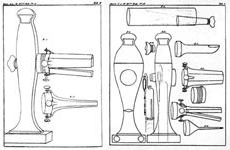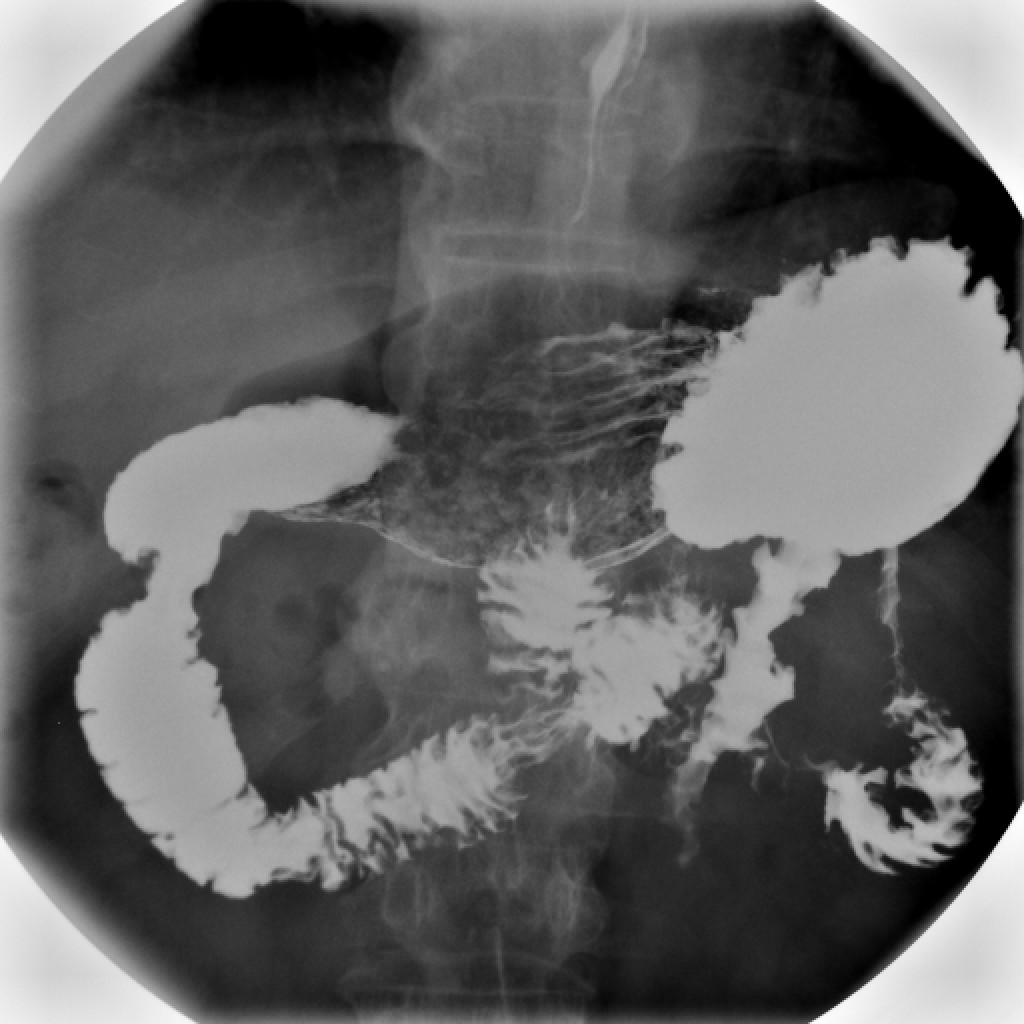|
Pulsion Diverticulum
A Zenker's diverticulum, also pharyngeal pouch, is a diverticulum of the mucosa of the human pharynx, just above the cricopharyngeal muscle (i.e. above the upper sphincter of the esophagus). It is a pseudo diverticulum or false diverticulum (only involving the mucosa and submucosa of the esophageal wall, not the adventitia), also known as a pulsion diverticulum. It was named in 1877 after Germany, German pathologist Friedrich Albert von Zenker. Signs and symptoms When there is excessive pressure within the lower human pharynx, pharynx, the weakest portion of the pharyngeal wall balloons out, forming a diverticulum which may reach several centimetres in diameter. While traction and pulsion mechanisms have long been deemed the main factors promoting development of a Zenker's diverticulum, current consensus considers occlusive mechanisms to be most important: uncoordinated swallowing, impaired relaxation and spasm of the cricopharyngeus muscle lead to an increase in pressure with ... [...More Info...] [...Related Items...] OR: [Wikipedia] [Google] [Baidu] |
Gastroenterology
Gastroenterology (from the Greek gastḗr- "belly", -énteron "intestine", and -logía "study of") is the branch of medicine focused on the digestive system and its disorders. The digestive system consists of the gastrointestinal tract, sometimes referred to as the ''GI tract,'' which includes the esophagus, stomach, small intestine and large intestine as well as the accessory organs of digestion which include the pancreas, gallbladder, and liver. The digestive system functions to move material through the GI tract via peristalsis, break down that material via digestion, absorb nutrients for use throughout the body, and remove waste from the body via defecation. Physicians who specialize in the medical specialty of gastroenterology are called gastroenterologists or sometimes ''GI doctors''. Some of the most common conditions managed by gastroenterologists include gastroesophageal reflux disease, gastrointestinal bleeding, irritable bowel syndrome, inflammatory bowel disease (IBD ... [...More Info...] [...Related Items...] OR: [Wikipedia] [Google] [Baidu] |
Regurgitation (digestion)
Regurgitation is the expulsion of material from the pharynx, or esophagus, usually characterized by the presence of undigested food or blood. Regurgitation is used by a number of species to feed their young. This is typically in circumstances where the young are at a fixed location and a parent must forage or hunt for food, especially under circumstances where the carriage of small prey would be subject to robbing by other predators or the whole prey is larger than can be carried to a den or nest. Some bird species also occasionally regurgitate Pellet (ornithology), pellets of indigestible matter such as bones and feathers. It is in most animals a normal and voluntary process unlike the complex vomiting reflex in response to toxins. Humans Regurgitation can be voluntary or involuntary for humans. It can occur alongside gastroesophageal reflux disease (GERD), acid reflux and some anatomical abnormalities. In infants however, regurgitation – or spitting up – is quite comm ... [...More Info...] [...Related Items...] OR: [Wikipedia] [Google] [Baidu] |
Barium Swallow
An upper gastrointestinal series, also called a barium swallow, barium study, or barium meal, is a series of radiographs used to examine the gastrointestinal tract for abnormalities. A contrast medium, usually a radiocontrast agent such as barium sulfate mixed with water, is ingested or instilled into the gastrointestinal tract, and X-rays are used to create radiographs of the regions of interest. The barium enhances the visibility of the relevant parts of the gastrointestinal tract by coating the inside wall of the tract and appearing white on the film. This in combination with other plain radiographs allows for the imaging of parts of the upper gastrointestinal tract such as the pharynx, larynx, esophagus, stomach, and small intestine such that the inside wall lining, size, shape, contour, and patency are visible to the examiner. With fluoroscopy, it is also possible to visualize the functional movement of examined organs such as swallowing, peristalsis, or sphincter closure. De ... [...More Info...] [...Related Items...] OR: [Wikipedia] [Google] [Baidu] |
Zenker22015Lateral
Zenker is the name of: * Friedrich Albert von Zenker (1825–1898) was a German pathologist, who named: ** Zenker's degeneration ** Zenker's diverticulum ** Zenker's fixative ** Zenker's paralysis * Georg August Zenker (1855–1922), German gardener and naturalist * Hans Zenker (1870–1932), German admiral * Jonathan Carl Zenker (1799–1837), German naturalist * Karl-Adolf Zenker (1907–1998) was a German admiral and son of Hans Zenker * Christian Zenker (1975), German tenor * Helmut Zenker (1949–2003), from Austria * Ramon Zenker Ramon Zenker (born 11 November 1968) is a German music producer, songwriter, Audio engineer, sound engineer and remixer. He is a member of Hardfloor, Fragma, Paffendorf and E-Trax, who had a UK Singles Chart, UK #60 hit with Let's Rock (song), Let ..., German music producer * Rudolf Zenker (1903–1984), heart surgeon * Wolfgang Zenker, (1898–1918), German military officer {{Surname [Baidu] |
Cricopharyngeus Muscle
The inferior pharyngeal constrictor muscle is a skeletal muscle of the neck. It is the thickest of the three outer pharyngeal muscles. It arises from the sides of the cricoid cartilage and the thyroid cartilage. It is supplied by the vagus nerve (CN X). It is active during swallowing, and partially during breathing and speech. It may be affected by Zenker's diverticulum. Structure The inferior pharyngeal constrictor muscle is composed of two parts. The first part (and more superior) arises from the thyroid cartilage (thyropharyngeal part), and the second part arises from the cricoid cartilage (cricopharyngeal part). * On the ''thyroid cartilage'', it arises from the oblique line on the side of the lamina, from the surface behind this nearly as far as the posterior border and from the inferior horn of the thyroid cartilage. * From the ''cricoid cartilage'', it arises in the interval between the cricothyroid muscle in front, and the articular facet for the inferior horn of th ... [...More Info...] [...Related Items...] OR: [Wikipedia] [Google] [Baidu] |
Killian–Jamieson Diverticulum
A Killian–Jamieson diverticulum is an outpouching of the esophagus just below the upper esophageal sphincter. The physicians that first discovered the diverticulum were Gustav Killian and James Jamieson. Diverticula are seldom larger than 1.5 cm, and are less frequent than the similar Zenker's diverticula. As opposed to a Zenker's, which is typically a posterior and inferior outpouching from the esophagus, a Killian–Jamieson diverticulum is typically an anterolateral outpouching at the level of the C5-C6 vertebral bodies, due to a congenital weakness in the cervical esophagus between the oblique and transverse fibers of the cricopharyngeus muscle. It is usually smaller in size than a Zenker's diverticulum, and typically asymptomatic. Although congenital, it is more commonly seen in elderly patients. Because of its relatively anterior positioning compared to a Zenker's diverticulum, surgical intervention to fix a Killian-Jamieson diverticulum has a higher risk of inj ... [...More Info...] [...Related Items...] OR: [Wikipedia] [Google] [Baidu] |
Esophageal Web
Esophageal webs are thin membranes occurring anywhere along the esophagus. Presentation Its main symptoms are pain and difficulty in swallowing (dysphagia). Esophageal webs are thin membranes of normal esophageal tissue consisting of mucosa and submucosa that can partially protrude/obstruct the esophagus. They can be congenital or acquired. Congenital webs commonly appear in the middle and inferior third of the esophagus, and they are more likely to be circumferential with a central or eccentric orifice. Acquired webs are much more common than congenital webs and typically appear in the cervical area (postcricoid). Clinical symptoms of this condition are selective (solid more than liquids) dysphagia, thoracic pain, nasopharyngeal reflux, aspiration, perforation and food impaction (the last two are very rare). file:Zervikales Web.jpg, Esophageal web stenosis in barium swallow examination lateral view. file:Web mit Jet-Phaenomen.jpg, Web with "jet-phenomenon". Arrowhead on inc ... [...More Info...] [...Related Items...] OR: [Wikipedia] [Google] [Baidu] |
Halitosis
Bad breath, also known as halitosis, is a symptom in which a noticeably unpleasant breath odour is present. It can result in anxiety among those affected. It is also associated with depression and symptoms of obsessive compulsive disorder. The concerns of bad breath may be divided into genuine and non-genuine cases. Of those who have genuine bad breath, about 85% of cases come from inside the mouth. The remaining cases are believed to be due to disorders in the nose, sinuses, throat, lungs, esophagus, or stomach. Rarely, bad breath can be due to an underlying medical condition such as liver failure or ketoacidosis. Non-genuine cases occur when someone complains of having bad breath but other people cannot detect it. This is estimated to make up between 5% and 72% of cases. The treatment depends on the underlying cause. Initial efforts may include tongue cleaning, mouthwash, and flossing. Tentative evidence supports the use of mouthwash containing chlorhexidine or cetylpyridi ... [...More Info...] [...Related Items...] OR: [Wikipedia] [Google] [Baidu] |
Cough
A cough is a sudden expulsion of air through the large breathing passages which can help clear them of fluids, irritants, foreign particles and Microorganism, microbes. As a protective reflex, coughing can be repetitive with the cough reflex following three phases: an inhalation, a forced exhalation against a closed glottis, and a violent release of air from the lungs following opening of the glottis, usually accompanied by a distinctive sound. Coughing into one's elbow or toward the ground—rather than forward at breathing height—can reduce the spread of infectious droplets in the air. Frequent coughing usually indicates the presence of a disease. Many viruses and bacteria benefit, from an evolutionary perspective, by causing the Host (biology), host to cough, which helps to spread the disease to new hosts. Irregular coughing is usually caused by a respiratory tract infection but can also be triggered by choking, smoking, air pollution, asthma, gastroesophageal reflux disease ... [...More Info...] [...Related Items...] OR: [Wikipedia] [Google] [Baidu] |




